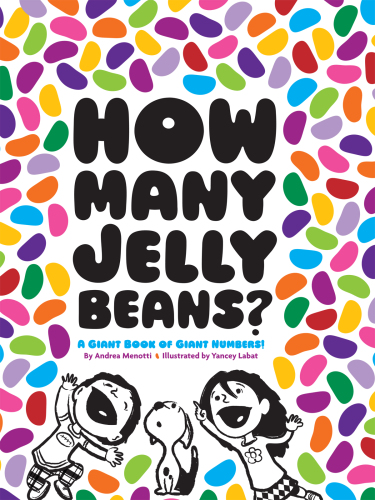
How Many Jelly Beans?
فرمت کتاب
ebook
تاریخ انتشار
2012
Reading Level
0-1
ATOS
1.5
Interest Level
K-3(LG)
نویسنده
Yancey Labatناشر
Chronicle Books LLCشابک
9781452113074
کتاب های مرتبط
- اطلاعات
- نقد و بررسی
- دیدگاه کاربران
نقد و بررسی

Starred review from May 14, 2012
This utterly delightful oversize book takes on big numbers, using jelly beans as counters. When Emma and Aiden are asked how many jelly beans they want, they carry on a boasting match, resulting in escalating amounts of candy (“He can have twenty? I’ll have twenty-five!”). Five hundred beans cover a coffee table, and 1,000 beans are divided out over the days of a year on calendar pages. The bright jelly beans are one of the few sources of color in Labat’s loosely sketched spreads, which culminate in a jaw-dropping 10-panel foldout finale for one million jelly beans. Next stop: the dentist. Ages 4–8.

April 1, 2012
Jellybean-fueled sibling rivalry leads readers on a visual exploration of large numbers. Emma's request for 10 is reasonable, as is Aiden's for 20, but, auction-style, the numbers soon mount from 100 to 500, at which point Emma calls Aiden's bluff. "That's too many. You can't eat five hundred jelly beans." Well, he could eat 1,000 in a year, but that's just two or three per day. How about 5,000 in a year? That would be a stack that's as high as a 10-story building. As the two ponder this existential conundrum, the numbers keep going up, from 10,000 to 100,000 to 1,000,000. Labat's black-and-white digital illustrations make the bright colors of the ever-increasing jellybeans stand out and pop off the pages. The speech bubbles, clean lines and efficiently drawn characters speak to his start in comics. The page depicting how Aiden would divvy 100,000 jellybeans among the different flavors works especially well, picturing single-color circles clearly labeled with the differing amounts (there's only one lemon jellybean). This helps readers learn to estimate, though Bruce Goldstone's Great Estimations and Greater Estimations (2006, 2008) offer more specific examples. An eminently child-friendly exploration of an ever-intriguing subject; pair it with David M. Schwartz and Steven Kellogg's How Much Is a Million. (Math picture book. 4-8)
COPYRIGHT(2012) Kirkus Reviews, ALL RIGHTS RESERVED.

June 1, 2012
Gr 2-5-Emma and Aiden begin a competition when asked how many jelly beans they would like. One asks for 10, the other asks for 20, then 25, and on through the hundreds, thousands, to a million. The actual number of jelly beans is displayed on each page in bright hues. As the quantities get larger, the beans get smaller and smaller, eventually making it impossible to count them individually but the math concepts are clear by comparing the masses. The children have fun adding, dividing, and comparing numbers of jelly beans to the height of a building. When they reach one million (an impressive 20-page gatefold), they concede that it's too many for any child to handle. Labat's artwork consists of bold black cartoon sketches and large expressive speech bubbles. Reminiscent of David M. Schwartz's How Much Is a Million? (HarperCollins, 1985), this book will help children grasp the concept of large numbers in a playful way. The gatefold gives an accurate account of what one million looks like but it is difficult to unfold and refold, and it requires an adult's assistance to prevent tearing. This oversize book is sure to catch the eye of curious kids and hold their attention.-Diane Antezzo, Ridgefield Library, CT
Copyright 2012 Library Journal, LLC Used with permission.

Starred review from July 1, 2012
Grades K-2 *Starred Review* Learning 1 to 10 can be a task, but once kids hear about the really big numbers, they often start throwing them around like candy. Here's an oversize book that visualizes for kids what they're already talking about in a clever, clear, and candy-coated fashion. The premise is simple and cleanly executed: two kids are asked how many jelly beans they'd like by an off-camera adult. Emma starts off with a handful of 10, which Aiden tops with his two-fisted 20. And so begins a war of escalation. As the numbers skyrocket from 25 and 100 to 10,000 and 100,000, the accompanying visuals match the numbers with, we think, corresponding, brightly colored jelly-bean dots. The exact numbers aren't the point, though; it's all about conceptualizing just how big those big numbers really are. And, as the enormous, multipage foldout packed full of a million jelly beans shows, they can get big enough to blow your mind. But it's not all abstraction, either: when Aiden boasts that in a whole year I could eat A THOUSAND JELLY BEANS, Emma realizes that that's only two or three jelly beans a day, so, duh, anyone could do that. This fresh approach to huge numbers should get kids thinking big time. Just wait'll they hear about a billion.(Reprinted with permission of Booklist, copyright 2012, American Library Association.)

























دیدگاه کاربران